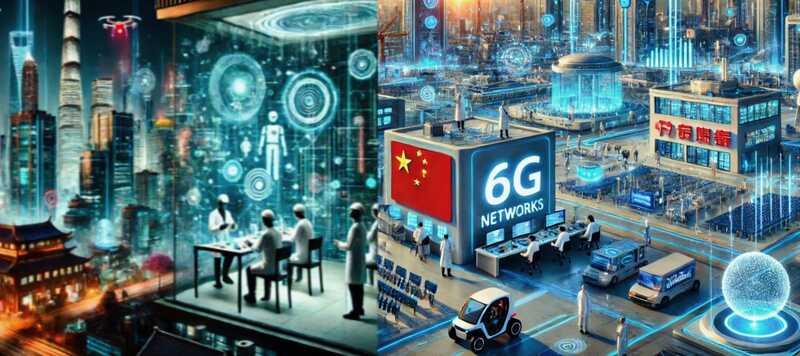 6G networks in use in China. Photo Credits. AI/Pixabay
6G networks in use in China. Photo Credits. AI/Pixabay
China’s Technological Supremacy: Ai, 6 G, And Semiconductors Leading Global Innovation
Asia
Innovation
For decades, Asia has been at the forefront of technological innovation, with nations like Japan, South Korea, and India excelling in robotics, artificial intelligence (AI), and chip manufacturing. However, in recent years, China has emerged as the central force redefining the direction of global technology. Through self-reliance, aggressive digitalization, and frontier innovation, China is transforming itself into a global tech powerhouse.
Strategic Emphasis on Innovation and Self-Reliance
China's recent "Two Sessions"—its key biannual political meetings—have reinforced the country’s commitment to innovation-driven development, highlighting ambitious plans to strengthen its technological capabilities. Central to this transformation is massive investment in research and development (R&D). In 2023, China’s R&D expenditure reached approximately $450 billion, or 2.55% of its GDP, with a focus on sectors expected to shape the future global economy: AI, quantum computing, 6G networks, biomanufacturing, and semiconductor production.
Breakthroughs in Frontier Technologies
Artificial Intelligence (AI)
China invested over $26 billion in AI in 2023, filing more than 40,000 AI-related patents, making it the global leader in AI innovation. Major tech firms like Baidu, Alibaba, and Tencent are spearheading AI development:
Strategic Emphasis on Innovation and Self-Reliance
China's recent "Two Sessions"—its key biannual political meetings—have reinforced the country’s commitment to innovation-driven development, highlighting ambitious plans to strengthen its technological capabilities. Central to this transformation is massive investment in research and development (R&D). In 2023, China’s R&D expenditure reached approximately $450 billion, or 2.55% of its GDP, with a focus on sectors expected to shape the future global economy: AI, quantum computing, 6G networks, biomanufacturing, and semiconductor production.
Breakthroughs in Frontier Technologies
Artificial Intelligence (AI)
China invested over $26 billion in AI in 2023, filing more than 40,000 AI-related patents, making it the global leader in AI innovation. Major tech firms like Baidu, Alibaba, and Tencent are spearheading AI development:
- Baidu has invested over $3 billion annually in AI cloud services and autonomous driving through its Apollo project.
- Alibaba has pledged $15 billion toward AI, cloud computing, and semiconductor R&D.
- Tencent has invested $7 billion in AI applications across gaming, fintech, and healthcare.
Quantum and 6G Technologies
China leads globally in quantum computing and communications, with $15 billion allocated to quantum research—surpassing both the U.S. and the EU. In 6G, China holds over 40% of global patents, and has already launched experimental satellites to test the technology.
Semiconductor Independence
To counter Western sanctions, China has prioritized domestic semiconductor production. Under its $150 billion National Integrated Circuit Industry Investment Fund, firms like SMIC have made progress toward 7nm and 5nm chip technology, directly challenging leaders such as TSMC and Samsung. As of 2023, China holds 29% of global semiconductor-related patents.
The Rise of Smart Manufacturing and Smart Cities
AI is revolutionizing service-oriented manufacturing, enabling higher precision, quality control, and cost reduction. This transformation is bolstering China’s position as the global factory of the future. Additionally, the integration of 5G and 6G infrastructure is laying the foundation for smart cities, where AI-enhanced planning and automation will streamline transportation, energy management, and public services.
Leadership in Green Technology
China is also asserting dominance in renewable energy and green innovation:
- $41 billion invested in solar power and $30 billion in wind energy in 2023.
- Over 60% of the world’s EV batteries are manufactured in China.
Investments in energy storage and hydrogen production are surging in line with China’s goal of achieving carbon neutrality by 2060.
These technologies are being exported globally, especially to developing countries, further strengthening China's position as a leader in the green transition.
Global Implications and Strategic Positioning
Despite foreign skepticism, often framing China's tech rise as a threat, many experts view China’s advancement as a net positive for global progress, particularly in areas like AI governance, intelligent manufacturing, and sustainable energy. China's comprehensive innovation strategy demonstrates long-term vision, economic resilience, and a firm intent to reshape the balance of technological power.
China is no longer just a follower in the global tech race—it is forging new paths ahead. From AI and quantum computing to semiconductors and green tech, China is not only catching up but defining the next chapter of global technological advancement. Its strategic investments and focus on self-reliance signal a future where China stands as a cornerstone of the world's innovation ecosystem.
Senior Editor: Kenneth Njoroge
Financial Expert/Bsc. Commerce/CPA
